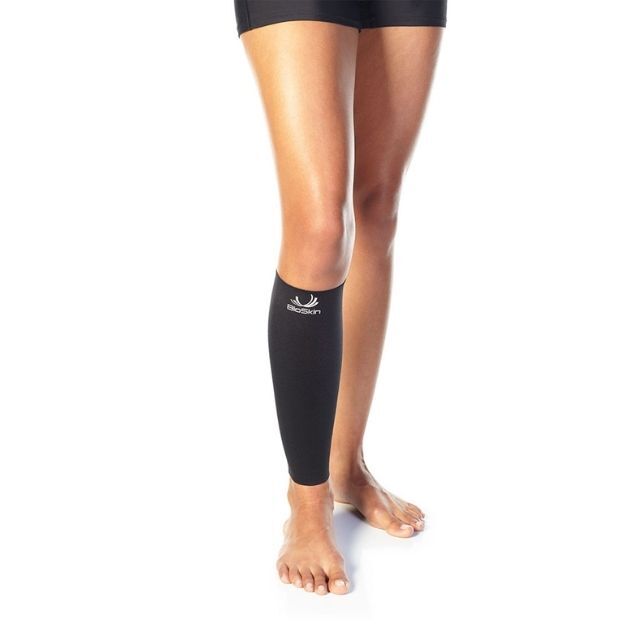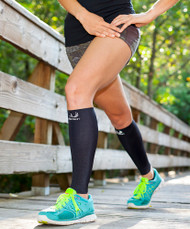A calf compression sleeve can be a helpful add-on when training or recovering: it applies graduated pressure at the lower leg to support venous return and help limit swelling. The compression sleeve isn’t a cure for injuries and won’t rebuild tissue on its own, but research most consistently shows benefits for perceived soreness and post-workout comfort.
In this guide, we’ll show you when sleeves make sense, how to pick the right compression and fit, and simple safety checks to keep your routine on track.
When a Sleeve Makes Sense (Use Cases)
A calf compression sleeve works best as a supportive tool for recovery. Here’s when it can genuinely help your legs feel better and move more comfortably.
After workouts or on high-mileage days
Using calf sleeves or compression calf sleeves after intense exercise can help reduce swelling and soreness by promoting blood flow and supporting the return of waste products from the muscles. Many athletes and runners use them to shorten downtime between training sessions and improve post-run comfort.
During long hours of sitting or standing
If you spend long periods on your feet or sitting, whether traveling, working, or cycling, graduated compression helps maintain circulation in the lower legs and reduces that heavy, tight feeling from fluid pooling around the ankle and calf.
Not a fix for shin splints by itself
While compression sleeves can make shin splints (medial tibial stress syndrome) feel more manageable, they don’t address the underlying cause. Use them as comfort support while you and your clinician fine-tune training load, footwear, and running mechanics.
Safety First: Who Should Not Use Compression (Or Should Ask First)
Compression can help many people, but it isn’t right for everyone. Always check with a clinician before using calf sleeves, compression socks, or leg sleeves if you have peripheral arterial disease, significant circulation problems, open skin wounds, or neuropathy that affects sensation. These conditions raise the risk of pressure-related injury or reduced blood flow if compression is too tight or improperly fitted.
Choose a sleeve that’s the perfect fit—it should fit snug, not squeeze or cause tingling, numbness, or color changes. If your legs feel unusually cold, painful, or swollen after wearing one, remove it and consult a healthcare professional.
Avoid sleeping in compression gear unless your clinician specifically recommends it. Most users benefit from daytime wear, when support and the breathable fabric material can safely improve blood flow and comfort during activity or recovery.
Picking the Right Compression Level
Compression sleeves come in different pressure ranges. The right one depends on your goals and health status. For most active people using sleeves for sport or recovery, mild to moderate compression is enough to support muscles, reduce inflammation, and encourage faster recovery without feeling overly tight.
Higher levels are considered medical-grade and are best selected with a clinician's input, especially if you have circulation issues or a history of leg swelling or vein problems.
What matters most is how accurately the sleeve delivers graduated compression. Always measure calf size at the widest point and follow the manufacturer’s chart closely. A sleeve that’s too tight can restrict movement and cause discomfort, while one that’s too loose won’t provide effective relief.
Think of compression as a balance. It must be firm enough to compress and support, but comfortable enough for regular wear and natural movement.
Fit and Sizing
Getting the fit right is what makes a calf compression sleeve effective and comfortable. Measure your leg first thing in the morning, when natural swelling is at its lowest.
Take two measurements (one around your ankle and one at the widest part of your calf), and use the product’s size chart. If you fall between two sizes, follow the recommendation of the manufacturer or consider how you’ll use the sleeve: closer fit for active performance, or slightly looser for all-day comfort.
When putting on the sleeve, roll it up, keep the fabric smooth, and make sure there are no folds that could cause tightness or pressure lines. The sleeve should feel snug but not restrictive. Remove it immediately if you notice numbness, tingling, color changes, or pain around the calf or Achilles area.
A proper fit ensures consistent compression, steady support, and long-lasting comfort, so your legs feel ready to move instead of fighting against the sleeve.
BioSkin Ultima Calf Sleeve

The BioSkin Ultima Calf Sleeve offers measured compression in a slim, breathable design for sport or everyday wear. It provides consistent support to help limit swelling and improve comfort during activity, all without bulk or heat buildup. Made with lightweight, moisture-wicking materials, it’s built for steady performance and day-long comfort.
Ready for a Clean Finish?
We design our gear to be simple, breathable, and effective. Pick your size in the BioSkin Ultima Calf Sleeve, add it to your cart, and get the steady compression you want for workouts and daily wear.
Frequently Asked Questions
Do compression calf sleeves help with recovery?
They can provide graduated pressure that supports venous return and may reduce post-workout soreness and swelling; they’re supportive tools, not injury cures.
What’s the difference between compression socks and leg sleeves?
Compression socks cover foot + calf (helpful for ankle/foot swelling), while leg sleeves cover only the calf. It's useful if you prefer your usual socks or need calf-focused support.
How does graduated compression work?
Pressure is highest at the ankle and decreases up the calf, helping move fluid back toward the heart; correct sizing is essential for safe, effective compression.
Are these sleeves a real game-changer, and how do I get a perfect fit?
They can make recovery feel better for many people, but results vary. Measure at the ankle and widest calf in the morning, follow the size chart exactly, and choose a snug—not tight—fit.


 British Pound
British Pound
